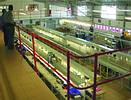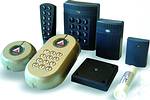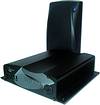

Forty years ago various card technologies were used in access systems, some proved to be so useful, that they are still in use today. Wiegand technology is a good example of this, and alongside MagStripe, is still available in significant quantities in the 21st century. These early systems were quite simple, having a limited set of features. Realtime clocks and database technology was in its infancy.
It is important to note that technology changes in leaps and bounds, but human acceptance is slow and discerning. In the late 1980s, local company Impro Technologies produced its first passive transponder, believing that the market would rejoice at the ease of use and security it would bring. But this was not the case. It took several years and multiple vendors all driving the market for acceptance of the new found capability.

Today, facilities embodied in access control go way beyond what could even have been contemplated in building management applications 20 years ago. As staff arrive and depart, airconditioning and lighting is automatically switched on, and security facilities ensure that people do not move into restricted areas whilst unoccupied by authorised personnel. Alarm zones are armed and disarmed automatically.
In days gone by schools were left unlocked. Today, not only is access control the order of the day in many First World schools, but it is necessary to couple this to metal detectors. Late comers are automatically diverted into the educational psychologist's office to assist them in coming to an understanding of the reasons why they felt the need to be late (probably, according to Freud, their parents are to blame)! The schools also want the ability to ensure that the correct candidate is writing the exam, as it is common practice for substitute pupils to sit exams.

Most of the changes occurring in the last few years in the First World access control markets can be attributed to 9/11. Before that AC meant airconditioning. Now it means access control. On entry to the United States, travellers are obliged to place a finger on a reader, to confirm the identity of the traveller, and to link them to any previous crime. This has spawned a major re-think in the minds of the man in the street, who now accepts it as a necessity that the doors remain locked. Motor vehicles left unattended with keys in the ignition and the engine running to keep the interior cool is a practice of days gone by.
It is amusing to note the change of attitude in the North American market. In the early 1990s it was not possible to sell vehicle access systems based on transponders in the ignition key, and absolutely no interest could be mustered for these systems. Security was of no concern whatsoever, and convenience their only requirement. The only question asked was: "how will it make my life easier?"
The mining industry is also a big user of transponder-based solutions. In one application, transmitters are placed inside the miner's cap lamp-battery, and they track the whereabouts of the miner. This technology is also used to identify the protected gear carried by the miner, eg, methane detectors. Miners are protected from injury, as the system allows them to be tracked when they are entering a danger zone, and appropriate action taken.

Asset and product tracking is another category which is growing rapidly. A practical application already in use is a system comprising of an adhesive tag, which is affixed into books in libraries for automatic allocation to students.
As the Internet and Ethernet usage expands worldwide, the need for TCP/IP enabled systems have blossomed. As cellphones and palm tops become web enabled, so access to the system in an office becomes open, irrespective of your location. Communication is the name of the game, with Dial Up/PSTN/ADSL, cable, Wi-Fi and Blue-Tooth standards emerging worldwide.
In spite of English being considered as the only language necessary in the English-speaking world, it is totally unacceptable to attempt to foist a particular language preference onto another person. Fully translatable systems are the order of the day, a fairly rudimentary task when the standard alphabet is in use. This is exacerbated as even within the same geographical areas, two groups seemingly using the same language have quite different meanings for the same words, and nuances need to be translated. Further, the difficulties of writing into Japanese, Chinese, Hebrew, Arabic, etc, abound, especially when writing from right to left is included in the equation. Today, the expectation is that any world-class product will be able to accommodate any language that can be typed, and localisation of the software can be done by anybody anywhere in the world.
Technology is changing all the time and the future holds exciting prospects for companies willing to take the risks associated with bringing innovative new products to the market place.

The company:
Impro Technologies
Impro Technologies was founded in 1986 emerging from image-processing (hence the name), through industrial process control application development, where the RFID technology was birthed, into access control. It launched its first access control system in 1989 and has been dedicated to the industry ever since. The company is still privately owned by the founding members.
As the company grew, so its distribution methodology changed, moving from a manufacturer/installer model to a design/manufacture with worldwide distributors. This was not always the case, however, but achieved by discontinuing direct end-user sales and selling off Impro Systems in Cape Town and Impro Distribution and Support in Durban, and establishing a single distribution sales office in Johannesburg.
Today the company has a well-establish-ed local distribution network through Blick, Reditron and Impro Distribution and Support (who have a custom software division and offer tailor-made solutions to their clientele using the Impro access control system as a base).
In 1995, Impro won the President's Award for Export and since then has continued its drive to increase exports. It currently exports to over 50 countries worldwide and has established offices in Tampa, Florida, USA to service North America and Canada, and in Amsterdam, The Netherlands, to service the Benelux region. Impro Japan now manufactures ISO cards, both Mifare as well as Manchester encoded, for the world market.

The research, development and manufacturing plant is based in Pinetown, Durban. In September 2002 a new factory was purpose built, increasing the floor space eightfold. In addition, a second PCB surface mount machine was imported to accommodate the increasing volume.
The aim has been to bring as much of the manufacturing process in-house to ensure quality control in order to satisfy the fiercely demanding Japanese market, as expressed in a statement from Errol East, joint managing director of Impro Technologies:
"Our entrance into the Japanese market has been a learning experience from day one. We have had to re-evaluate the way we design, manufacturer and test our products. Our management systems employed are essential, quality controls are paramount, and ISO 9001 is not just a convenient sales advertisement. It is in place to ensure that consistent top quality products emerge, some with lifetime guarantees. It was extremely demanding and daunting to conform to the Japanese standards but there is no doubt that we have benefited from it and that all our customers will reap these benefits."
It is interesting to note that Impro was probably the first company in the world to manufacture its own integrated circuit specifically designed for inclusion in a tag. This was done at SAMES in Pretoria, and completed by 1990.
In 2000, Impro established a new company named IdentiTag, to focus on the non-access product range, so that Impro could concentrate on its core business, access control. As such, all rights were sold to IdentiTag for the Impro fuel control system, animal identification and vehicle key control. This company is now highly successful with its drive into Africa, Europe, Australasia and America.
As far as local development and quality standards go, Errol East says further:
"Impro is a fully South African company. We design and manufacture all the equipment in the Durban office. We believe that it is not possible to have a thriving international market without succeeding at home. As such, great emphasis is placed on the local market, and our aim is to achieve number one position in South Africa. As noted before, the company prides itself on ISO 9001, which insists that from product conception, through design and into manufacture, all facets fully conform to the requirements to produce quality products consistently. Today, the approval marks for CE, FCC, ETSI standard are affixed to virtually all Impro's product range. The need for UL standards in the US has prompted a program to have the products approved with this mark as well."
Impro Technologies' products
Impro Technologies established its name in the access control market due to the huge success of the Link-Scan and Multi-Scan ranges. The Scan range is still sold today, over 15 years after its launch, with many tens of thousands of sites still running worldwide.
As with all technology, demands and requirements change and the Scan range could no longer fulfil the market demands of the 21st century.
With development starting in 1998, in 2001 Impro launched the IXP range which was designed to handle all access control applications from single door systems through to multinational systems of up to 3000 doors per site. Throughout the world there was an increased need for information on demand and a single system to monitor multiple aspects of a companies' operation, including access control, building management, elevator control, CCTV, intrusion plus time and attendance. The end user wanted an integrated solution that could be operated from anywhere in the world. Impro's answer was to invent the ImproNet Architecture and produce the platform independent IXP400 Access Control System, which was written in Java (in actual fact, all the IXP systems are 100% pure Java). This uniquely flexible system has become a full management system rather than just a security solution or simple access control solution.
The open database structure of the system allows system integrators to seamlessly connect to enterprise systems such as SAP, asset management systems, and other third party databases for added value and efficiency. The need for duplicate entries and reports from multiple databases is removed.
Impro also manufacture a range of radio frequency transmitters and receivers, used primarily for vehicle access and in the mining industry. Impro also manufacture a range of adhesive label tags for asset and product tracking.
The future holds exciting prospects and Impro is looking ahead to introducing new, more powerful products. In October 2004, the baby of the new range - the IXP121 - will be launched.

Showcasing an advanced access control architecture: Impro's ImproNet System
Integration is the name of the game, and access control forms a very significant building block in the human resources chain. From simply opening the door, it holds primary information to enable time and attendance reports, and therefore salary information, job costing, canteen management, building facility control, security, etc. This being the case, often the third party program needs to effect closer control of the events, rather than simply being advised from a transaction report that a particular event had occurred at some time in the past. To address this need, Impro invented the ImproNet Architecture. Impro's IXP400 software suite implements the ImproNet architecture. While this cliché is often bandied about, the ImproNet suite is truly an 'Open-architecture'.
A four-step design was used:
1. Give unrestricted access to third parties to transactions received from the field controllers, using either SQL Server, Oracle, or the Open Source Firebird Database.
2. Interact with the live database, updating the information on-line, using standard SQL Language instructions and allow any other party (with the correct password) to do the same.
a. This accepts input from any program, and will send data off to the field hardware, allowing third party software to actually alter the data in the Impro Controllers. To give an example, a human resources program, capturing details from a new employee can directly update the database with the information. This will automatically find its way into the hardware within a few seconds at most, so the next time they clock in, the system is aware of their presence. Two independent data capture actions capturing the same data is eliminated, so that databases do not go out of synchronisation.
3. Use Standard TCP/IP Socket interconnection protocol for immediate events at the units in the field. This allows third party software to open a door, or switch on a relay, or, in fact, everything that ImproNet can do, is available to them.
4. Make a service called 'third party validator'. This allows the customer to instruct the ImproNet system NOT to make a decision at a specific zone, (eg, the entrance) but pass the request for access to a third party validator software. Thus the final validation decision rests with the third party.
It is interesting to see how this has worked in practice. In a particular factory, medical check-ups are required for each member of staff who spends a certain number of hours in a specific part of the plant.
As such, they link the group of readers allowing entrance to the area to request permission from another system. In this case, SAP.
On a tag being presented, the system sends the request for access through to the utility that passes it onto SAP, and SAP either lets the person in, or unlocks the door that leads to the doctor!
Capturing CCTV images is paramount in identification, because an access system knows the whereabouts of personnel and linking to access systems provides the interface. To achieve this, Impro has integrated with several vendors, and is busy with several more. Impro has also produced its own CCTV integrated suite, namely iNetDVR.
The support of multiple Microsoft operating systems, starting with Windows 95, 98, NT, 2000, 2003, XP, etc, is a daunting task, as they are certainly backward compatible. Features and facilities that work perfectly in one version do not work in another. On top of this problem, Microsoft software in multiple languages brings another set of complications. Nevertheless, Impro systems are able to work with a vast majority of Microsoft operating systems as well as other platforms, eg, Linux.
Read/write cards were heralded as the requirement of the modern access control system. In spite of Impro designing its reader systems to allow both read only and read/write to operate simultaneously, in the past this technology has generally been a 'damp squid' in access control. The fickle market simply buys the cheapest card solution, and could not care less about potential features. Not so Japan, where virtually every scholar carries a MiFare card (Sony have recently released its alternative - Felica). Today however, an increasing interest in is shown in the technology, especially 13,56 MHz.
ImproNet also offers choices when it comes to tag technologies (there is a need to be 'open' here as well). It is an interesting debate to consider the benefit of 13,56 MHz compared to the well known 125 KHz systems. Impro offers both technologies, so feels that it is able to make an unbiased comparison.
If the card is used for access only, it is pointless to have the 13,56 technology, as the cost increase does nothing for the benefits. The reason for this is that 125 KHz operating at approximately 4000 bits/s data rate, is sufficiently fast to provide the user undelayed access.
Both 125 KHz as well as 13,56 MHz offer read/write, multiple card simultaneous presentation, tiny size, security features, etc.
However, 13,56 MHz comes to the fore where either large amounts of data need to be written, high security is required or where multiple users are making transfers into the various sections of the card memory. Casino chips and the like are good examples of the need to quickly identify multiple chips.
ImproNet, with its various hooks and facilities for integration allows enterprise users to totally customise their implementation of Impro's access control system to work as they see fit. Errol East of Impro likes to joke, "If we had not desired to name our product 'ImproNet' because of our company name, we would have called it 'OpenNet' instead."
For more information contact Barry East, Impro Technologies, 031 700 1087, fax: 031 700 1511, [email protected], www.impro.net

© Technews Publishing (Pty) Ltd. | All Rights Reserved.